Good Samaritan Hospital Vascular Surgery
The Vascular Surgery team is a highly-specialized team of specialists that treat diseases of the vascular system. We provide total comprehensive vascular care to patients with peripheral vascular diseases.
The team includes specialists in vascular surgery, interventional radiology, vascular anesthesia, wound care, vascular operating room nurses and technicians as well as lymphedema therapists and physical therapists.
Many of the vascular conditions are treated with the use of balloon catheters and stents to improve blood flow without major surgery. These minimally invasive treatments are collectively called endovascular procedures. This results in quicker recovery with less pain.
Three of the most recognized vascular diseases are abdominal aortic aneurysm (AAA), an enlargement in the largest artery that pushes against the aortic wall, carotid artery disease, a buildup of plaque that can cause a stroke, and peripheral arterial disease, hardening of the arteries that causes a buildup of plaque in the blood vessels. Other vascular conditions that are treated at Good Samaritan Hospital include aortic arch conditions, aortoiliac occlusive disease, dialysis access, chronic venous insufficiency, deep vein thrombosis (DVT), diabetic vascular disease and lymphedema.
What Is Vascular Disease?
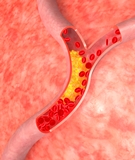
Vascular disease is any abnormal condition of the blood vessels (arteries and veins). The body uses blood vessels to circulate blood through itself. Problems along this vast network can cause severe disability and death.
Vascular diseases outside the heart can “present” themselves anywhere. The most common vascular diseases are stroke, peripheral artery disease (PAD), abdominal aortic aneurysm (AAA), carotid artery disease (CAD), arteriovenous malformation (AVM), critical limb ischemia (CLI), pulmonary embolism (blood clots), deep vein thrombosis (DVT), chronic venous insufficiency (CVI), and varicose veins.
Everyone is at risk for vascular disease. With the increase in obesity and Type II diabetes in Americans and as the population ages, vascular diseases are becoming epidemic. PAD alone affects 8.5 million people. It can occur in anyone at any time; affecting men and women equally. Atherosclerosis can begin in adolescence.
Vascular Conditions
Three of the most recognized vascular diseases are abdominal aortic aneurysm (AAA), an enlargement in the largest artery that pushes against the aortic wall, carotid artery disease, a buildup of plaque that can cause a stroke, and peripheral arterial disease, hardening of the arteries that causes a buildup of plaque in the blood vessels. Other vascular conditions that are treated at Good Samaritan Hospital include aortic arch conditions, aortoiliac occlusive disease, arm artery disease, chronic venous insufficiency, deep vein thrombosis (DVT), diabetic vascular disease and digital artery conditions.
Most Americans are familiar with heart disease and with the consequences of blockages in the vessels that carry blood to and from the heart. But few people realize that blockages caused by a buildup of plaque and cholesterol affect more than coronary arteries. Arteries throughout the body carry oxygen-rich blood away from the heart, so blockages can occur in all arteries with serious effects. Three of the most recognized vascular diseases include:
Abdominal Aortic Aneurysm
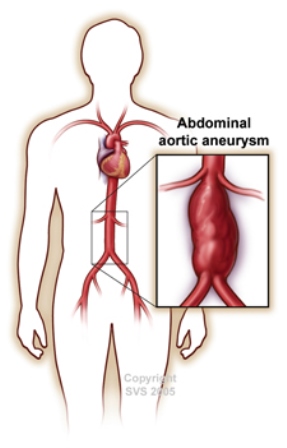
Abdominal Aortic Aneurysm (AAA) is an enlargement or “bulge” that develops in a weakened area within the largest artery in the abdomen. The pressure generated by each heartbeat pushes against the weakened aortic wall, causing the aneurysm to enlarge. If the AAA remains undetected, the aortic wall continues to weaken, and the aneurysm continues to grow. Eventually, the aneurysm becomes so large, and its wall so weak, that rupture occurs. When this happens there is massive internal bleeding, a situation that is usually fatal. The only way to break this cycle is to find the AAA before it ruptures.
Carotid Artery Disease - Stroke
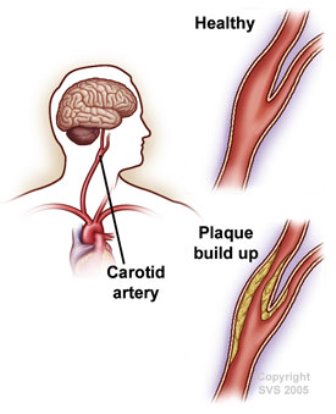
Carotid arteries occur when the main blood vessels to the brain develop a buildup of plaque caused by atherosclerosis, or hardening of the arteries. When the buildup becomes very severe, it can cause a stroke. A stroke occurs when part of the brain is damaged by these vascular problems; in fact, 80 percent of strokes are “ischemic strokes” where part of the circulation to the brain is cut off, usually due to blockages in the carotid arteries. The process is similar to the buildup of plaque in arteries in the heart that causes heart attacks. Strokes are the third leading cause of death in the United States according to the National Center for Health Statistics.
Peripheral Arterial Disease
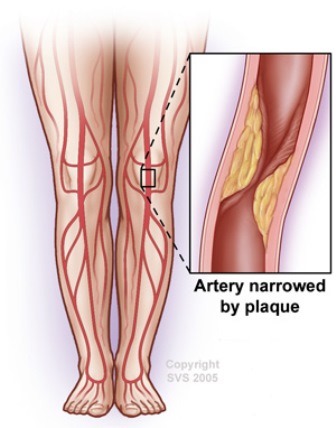
Peripheral arterial disease (PAD) occurs when atherosclerosis, or hardening of the arteries, causes a buildup of plaque in the blood vessels that carry oxygen and nutrients to all the tissues of the body. As these plaques worsen, they reduce essential blood flow to the limbs and can even cause complete blockages of the arteries. Early on, PAD may only cause difficulty walking, but in its most severe forms, it can cause painful foot ulcers, infections, and even gangrene, which could require amputation. People with PAD are three times more likely to die of heart attacks or strokes than those without PAD.
Meet Our Team
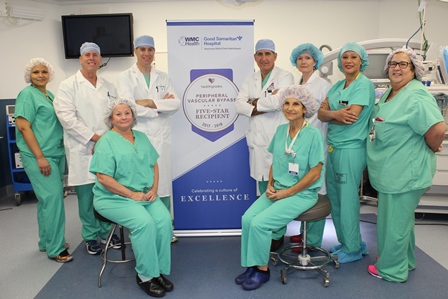
The Vascular Surgery team is a highly-specialized team of specialists that treat diseases of the vascular system. The team includes specialists in interventional radiology, vascular anesthesia and wound care, vascular operating room nurses and technicians as well as lymphedema physical therapists.
Michael Schwartz, MD, Chief of Vascular Surgery, Good Samaritan Hospital
Dr. Michael Schwartz is a board-certified vascular surgeon who specializes in Vascular Surgery and Vascular Interpretation. He received his medical degree from University of South Florida College of Medicine and completed his general surgery residency at Montefiore Medical Center / Albert Einstein College of Medicine, New York, NY where he was the Chief Resident. Dr. Schwartz also performed his fellowship in vascular surgery at Montefiore Medical Center / Albert Einstein College of Medicine. Dr. Schwartz has published extensively and is known for his clinical research in the area of stented graft treatments and procedures. He has been in practice for more than twenty years, with nearly fifteen of those years at Good Samaritan Hospital.
Scott Luchs, MD, Director of Radiology, Director of Interventional Radiology, Good Samaritan Hospital
Dr. Luchs is a board-certified diagnostic and interventional radiologist who has been practicing at Good Samaritan Hospital for nearly twenty years. Hailing originally from nearby Englewood NJ, Dr. Luchs went to college at Brandeis University, before completing his Masters in Medical Science and MD at Boston University Medical School. He performed his surgical internship at Montefiore Medical Center in the Bronx, and completed his residency in diagnostic radiology at Norwalk Hospital/Yale University in New Haven, CT. Dr. Luchs returned to Boston University to perform his vascular and interventional radiology fellowship. He specializes in interventional and vascular radiology and has been working in collaboration with Dr. Schwartz for over twenty years.
H. Michael Choi, MD, Chief of Endovascular Surgery; Director, Vascular Lab, Good Samaritan Hospital
Dr. Choi is board-certified in general and vascular surgery, specializing in endovascular procedures. He received his medical degree from Icahn School of Medicine at Mount Sinai, in NY and completed his general surgical residency at The University of Medicine and Dentistry of New Jersey (UMDNJ). Dr. Choi also performed his vascular surgery fellowship at The University of Medicine and Dentistry of New Jersey (UMDNJ.) He has been in practice for more than twenty years and is able to treat a diverse population as he speaks Korean and English.
Sean Wengerter, MD, Vascular Surgeon, Good Samaritan Hospital
Dr. Wengerter specializes in general and vascular surgery. He received his medical degree from Rutgers New Jersey Medical School in Newark, NJ and completed his general surgical residency at Icahn School of Medicine at Mount Sinai in NY. Dr. Wengerter also performed his vascular surgery residency at Icahn School of Medicine at Mount Sinai.
Hear from Our Patients

James Guardino, a Rockland County grandfather, recently celebrated Father’s Day after surviving a life-threatening condition

Thanks to the quick-thinking of our ED and vascular surgery teams, James, pictured with Robin Kim, MD, has a new lease on the life he loves: fishing, motorcycling, bocce and spending time with his son and grandson.
It all started on a cool spring day when James Guardino was enjoying lunch with his wife, Claudia and his mother-in-law at their home in Chestnut Ridge. Then he went outside like he always does to smoke a cigar. As he lit the cigar, he felt a tingling in his hands and put the cigar down. Soon after, he felt nauseous and threw up. He asked his wife to come outside and she said it’s probably just a stomach ache. But then he threw up again and his right arm started shaking. His wife called 911 and his son, Jimmy, met the ambulance at the house. “He was shaking like a leaf,” said Jimmy. “We had just talked on the phone a few hours ago.” The ambulance arrived within minutes and brought him to Good Samaritan Hospital. Robin Kim, MD, Medical Director of the Emergency Department, and his team of nurses immediately met the ambulance. Dr. Kim examined Mr. Guardino and felt a mass in his abdomen. He quickly sent Mr. Guardino for a CT scan, suspecting that it might be a ruptured abdominal aneurism. Dr. Kim took immediate action and called Vascular Surgeons Michael Schwartz, MD, Director of Surgery, Matthew Carpiniello, MD, and Sean Wengerter, MD. Within 30 minutes, Mr. Guardino was in surgery. The physicians performed an abdominal aortic aneurysm surgical repair, making a large incision in the abdomen to expose the aorta. Once the abdomen is open, a graft (a synthetic tube) is used to repair the aneurysm. Mr. Guardino recovered in the hospital for eight days including two and a half days spent on a respirator. He didn’t have an appetite for a while, “except for pasta!” Mr. Guardino joked. “This event was life-threatening and it was the efficiency and timing of the staff at Good Samaritan Hospital that saved Mr. Guardino’s life,” said Dr. Kim. Three months later, Mr. Guardino proudly showed off his 12” scar. “I asked my wife, ‘how am I going to go to the beach? She jokingly told me, ‘tell everyone you were bitten by a shark!’”
After Years of Pain From a Hidden Condition, This Grandmother Got Help From Good Samaritan Hospital
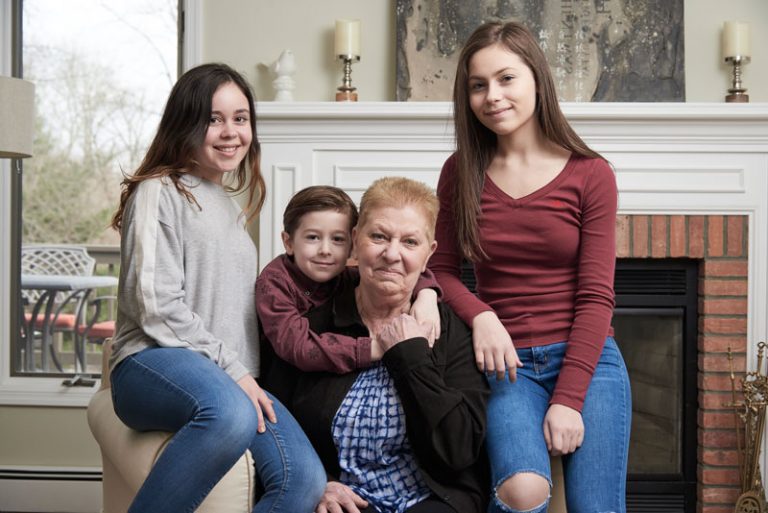
Congers’ Kathleen Paladine found relief from artery disease, thanks to this hospital’s skilled vascular team.
By Debra Bresnan
When Kathleen Paladine’s leg pain became so bad that “it felt like somebody was twisting it,” she blamed it on a relapse of her sciatica.
Experiencing pain in her thighs and the back of her legs, she turned to chiropractic treatments, acupuncture, physical therapy and even B12 shots and anti-inflammatory injections for relief. But nothing helped. “I couldn’t walk more than 100 feet without having to stop,” recalls the Congers resident. “I became a potted plant.”
After 4 ½ years of nearly constant pain, her primary care doctor referred her to a cardiologist, who ordered angiograms of her legs. When the test results indicated long arterial blockages, the 70-year-old grandmother was referred to Michael Schwartz, MD, Chief of Vascular Surgery at Good Samaritan Hospital, a member of the Westchester Medical Center Health Network (WMCHealth).
Dr. Schwartz diagnosed Paladine with Peripheral Artery Disease (PAD), a hardening of the arteries that causes a buildup of plaque in blood vessels, and recommended vascular bypass surgery. She chose to have her surgery at Good Samaritan Hospital when she learned her hospital stay would be two days rather than a week at another hospital, as was suggested by another vascular surgeon.
Dr. Schwartz performed vascular bypass surgery on Paladine on October 26. He used one of her veins to create a conduit to bypass her arterial blockage. Though her incision was nearly 17 inches long, she was walking shortly after the surgery. Following her initial physical therapy sessions in Good Samaritan Hospital’s Intensive Care Unit (ICU), she returned home on the third day to continue at-home physical therapy sessions.
Paladine has since regained good quality of life and is looking forward to taking walks around Rockland Lake again when the weather warms.
The 14-member vascular surgery team specializes in treating vascular system diseases — including the three most serious vascular diseases (aortic aneurysm, carotid artery disease and peripheral artery disease), as well as other vascular conditions, such as varicose veins, hemodialysis access, chronic venous insufficiency and lymphedema.
The team includes experts in surgery, interventional radiology, vascular anesthesia and wound care, as well as vascular operating-room nurses and physical therapists. Dr. Schwartz says, “Our team is uniquely equipped to care for vascular patients. Our surgical ICU is able to mobilize patients quickly and get them back home, usually within two days following surgery.”
“I had excellent care at Good Samaritan Hospital,” says Paladine, whose only other prior health issue besides sciatica was high blood pressure.
“I had never had surgery before, and I was petrified, but I was so impressed. Dr. Schwartz is phenomenal and I felt very, very comfortable under his care. The same is true for all the nurses and the rest of his team, too,” she says.
However, Paladine also cautions: “If you have symptoms similar to what I had, don’t take it for granted that they’re coming from one source. I had gone to have an MRI, and it showed that my sciatic nerve was pinched. I thought that was my problem before I had the additional testing done.”
Though most common among people in their 60s, 70s and 80s, the symptoms of vascular artery diseases may also present earlier in people with a family history or among diabetics and heavy smokers.
“We have better tools to diagnose vascular disease, and there’s a plethora of minimally invasive options available for treatment,” says Dr. Schwartz. “Some of the newer statin drugs and blood thinners have decreased the number of people with symptomatic vascular diseases. Nevertheless, we see a fair number of cases in smokers or diabetics who need treatment.”
Dr. Schwartz advises people to regularly visit their primary care doctors to discuss any issues or symptoms. “Exercising regularly, eating correctly and avoiding smoking can all help prevent worsening vascular disease. Most people with PAD can and should be treated conservatively, with exercise and physical therapy. Unfortunately, there aren’t any drugs that are really effective in treating it when it develops,” says Dr. Schwartz. “In Kathleen’s case, initial attempts to treat her with conservative measures were ineffective, so we opted for surgery.”
Paladine moved from Staten Island to Congers four years ago to live with her son, daughter-in-law and three grandchildren (ages 16, 14 and 6). Now that she’s successfully recovered from her vascular surgery, she’s back to enjoying being a homemaker and cooking dinners each evening for her family.
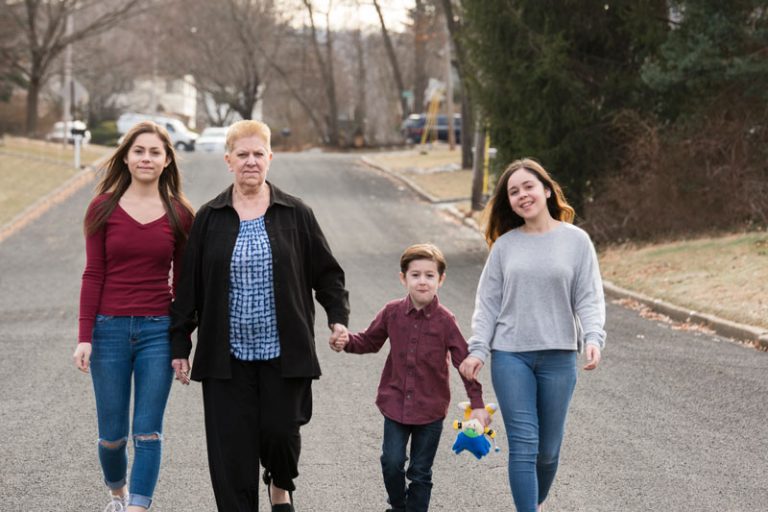
Best of all, she’s comfortable taking walks in her neighborhood again, her favorite form of exercise, and she hopes to get back on her treadmill again soon, too. “Before my surgery, I had terrible cramps in my calves and it took me 10 to 15 minutes to walk to the bus stop with my grandson. It was only about five houses away from our home, but that short walk felt like climbing Mount Everest to me. I had to stop every five or six steps to rest. Now I can do it in just five minutes, without stopping. I do my own housecleaning in our house, go shopping and stay busy.”
“I see a big improvement, and I’m glad I got my surgery done. I wish I’d done it sooner.”